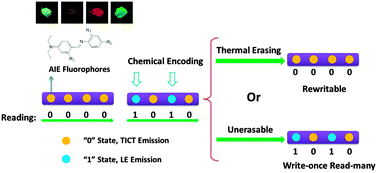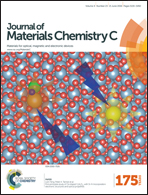Stimuli-responsive fluorophores with aggregation-induced emission: implication for dual-channel optical data storage†
Abstract
For optical data storage (ODSes), fluorescence may be an ideal computer-readable signal on account of its scalability, correction capability, and potentially enhanced capacity. In this study, we report the synthesis and photoluminescence (PL) behaviour of a class of fluorophores with electron donor and acceptor units. They exhibit AIE properties with long-wavelength emission colour. Owing to the reactive electron withdrawing group, their emission spectra have shown either “on–off” switching or a remarkable blue-shift upon alkali treatment. The changes in their fluorescence are due to TICT–LE transition as confirmed by their absorption spectra and DFT calculation. The fluorescent response can be recovered or not, depending on the chemical stimulant used for encoding. Based on the stimuli-responsive nature of the fluorophores, we have further developed both rewritable and write-once read-many (WORM) ODSes with single or dual-channel outputs. “0” and “1” state of the encoded binary data, corresponding to the TICT and LE emission, can be read easily using a spectrofluorophotometer. In addition, the WORM ODSes enjoy the advantage of long-term stability and the rewritable ODSes can be reused many times without fatigue.


 Please wait while we load your content...
Please wait while we load your content...